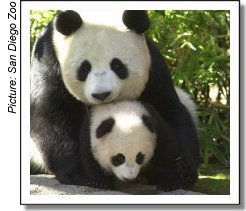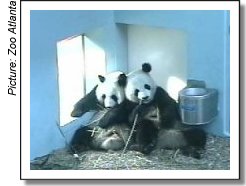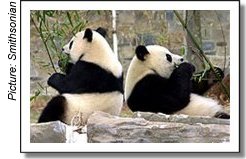According to Chinese astrology, Y2K is the year of the dragon. For me, however, it has definitely been the year of the giant pandas.
 | San Diego Pandas Gallery | | San Diego Pandas Gallery | |
Early in the year, I was reading the book God is in all the Small Stuff and decided to take up the challenge to "choose a topic of interest and spend the next twelve months learning all you can about it". This was just before the middle of January. I think I decided to focus on something Chinese, and decided giant pandas were Chinese enough. So I did a search on the Net for giant pandas and very quickly came up with the San Diego Zoo's web pages on their giant panda baby, Hua Mei, and her parents, Shi Shi and Bai Yun. Shi Shi is Chinese for "stone" while Bai Yun means "white cloud" in Chinese. Their baby, Hua Mei, was named on her 100th day of birth. Her name, carefully chosen to signify the Chinese and American collaboration in San Diego Zoo's giant panda conservation project, takes one character each from the two names of the two partner countries - Hua, representing China, and Mei, representing America.
 |
Since January 2000, I have learned many things about the giant panda. It is amazing how, once I decided on my topic of interest for the year, the information came to me almost effortlessly. For example, the February issue of the Asian edition of The Reader’s Digest had on its cover a picture of Dr Pan Wenshi, noted Chinese biologist dedicated to giant panda study and conservation, and one of his "babies", Da Bao. Over the next two months (February and March), the National Geographic channel on Astro (Malaysian satellite television provider) ran and repeated three separate documentaries on the giant panda. So, within a relatively short time, I learned a lot about the giant panda. In particular, I was totally amazed by how small they are at birth, how high their infant mortality rate, and how threatened they are by extinction.
 | Atlanta Pandas Gallery | | Atlanta Pandas Gallery | |
My focus on the giant pandas also happened at a time when there was increased interest and attention on the black and white furry creature. Hua Mei, the San Diego Zoo's baby giant panda, had been born in August 1999. In early November, Zoo Atlanta took delivery of their two giant pandas, Lun Lun and Yang Yang, on loan from Chengdu Zoo in China. Around that time, Hsing-Hsing, the sole surviving giant panda at the National Zoo in Washington, DC, was dying and in late November, a decision was made to euthanise him. His death resulted in a wave of mourning at the American capital city normally reserved for human beings.

Hsing Hsing |
From various accounts published at the time of his death, it was clear that Hsing-Hsing and his mate, Ling-Ling, had been a part of American life ever since they arrived in 1972 as a gift from the Chinese Government to the Americans. For many Americans growing up in the 1960s and through to the 90s, Hsing-Hsing and Ling-Ling were like family, so their deaths - Ling-Ling had died in 1992 of heart failure - were like a death in the family.

Ling Ling |
Before my quest to learn all I can about the giant pandas, I knew very little about the animal. I did know they were very special animals and very synonymous with China. In fact, I remember buying a wall hanging for a friend in the late 1980s which showed a giant panda eating bamboo and the words "Giant Panda - China's Treasure" in Chinese. Beyond that, I had no interest in the animal until my decision to focus on them in the year 2000. When I learned about Hsing-Hsing and Ling-Ling, I remember having visited Washington, DC in 1990 but not knowing they were in the National Zoo there. I visited various Smithsonian museums but not the National Zoo. I don't think I would have been interested in visiting a zoo in those days - whatever childhood memories I have of zoos have not been good ones. It upset me that I was in the same city as Hsing-Hsing and Ling-Ling in 1990 but was totally ignorant of their existence then and up to early last year. I must really live in a box because these two creatures were very famous in their day - just the other day, a colleague remembered reading about the two of them and how difficult it was for Ling-Ling to conceive.
 | National Zoo Pandas Gallery | | National Zoo Pandas Gallery | |
If I had known about Hsing-Hsing and Ling-Ling back in 1990 and gone to see them at the National Zoo, would my love affair with the giant panda have started a decade earlier? I don’t know, but I do believe everything happens for a reason - my visit to Washington, DC in 1990 without knowing about its famous giant panda residents, my decision to focus on the species for Y2K, etc. Even Hsing-Hsing’s death happened for a reason. I know many giant panda lovers mourned his death and wondered why he had to be put to sleep. But remember, he did live to a ripe old age for a giant panda - he was 28 when he died, the equivalent of 112 in human age - and he was suffering so it was time for him to go. But his death opened the door for the National Zoo to apply for the loan of another pair of giant pandas for their conservation research study. It is appropriate that exactly a year to Hsing-Hsing’s death on 28 November 1999, a team from the National Zoo were on their way to China to take delivery of the two latest additions to the giant panda population in the States - Tian Tian, male, 3½, and Mei Xiang, female, 2½. They arrived at the National Zoo on 6 December 2000 to undergo a 30-day quarantine period before going on public display. As I write this in early January 2001, Tian Tian and Mei Xiang are just days away from their debut in the States. By the time this eventually sees the light of day, they would have been delighting visitors to the National Zoo for about five months! I wish I could be there to see them “live”. | Even though I am not able to be in Washington, DC, to see Tian Tian and Mei Xiang in person, I have been visiting them almost every evening Malaysian Time since the middle of December 2000. The wonders of the Internet and the generosity of the Zoo's giant panda conservation sponsors (Discovery Channel's Animal Planet and FedEx) have provided for a bank of 20 "live" web cams to display the pair on the Internet way before their actual "live" debut. Similar cam set-ups at San Diego Zoo and Zoo Atlanta have allowed me to keep track of Hua Mei and Bai Yun at the former and Lun Lun and Yang Yang at the latter.
|
A friend recently asked me what I do to relax. Well, I go online to check on the panda cams to see how my "babies" are coming along, and when it's too late to see them (their time, not mine), I look at my collection of panda pictures. It's guaranteed to put a smile on my face or raise a chuckle from deep within. | | | | | | | | |







Arachnophilia
